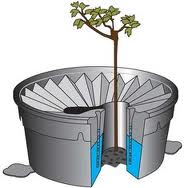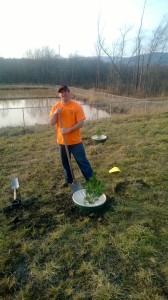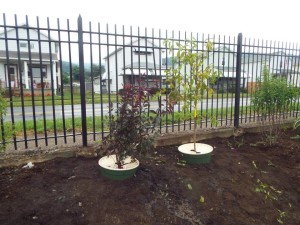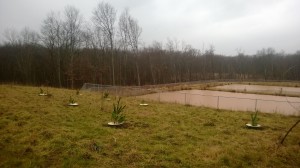Inquiring Systems Inc., a California non-profit corporation has awarded EPCAMR with a 2 Year, $15,000 project management agreement to continue research work and to promote the use of the innovative Waterboxx Technology, patented by Groassis, an international company founded in Holland, for planting tree seedlings in our communities, on our abandoned mine lands, in local municipalities, along mine drainage treatment systems, on school grounds, and in community and historic parks.

Schematic of a Waterboxx

Robert planting a Waterboxx at the Espy Run AMD Treatment System on Earth Conservancy property, located in Hanover Township, on an formerly abandoned mine land problem area that has been reclaimed.
Eastern Pennsylvania Coalition for Abandoned Mine Reclamation (EPCAMR) will serve as the lead regional environmental non-profit organization from the Northern Anthracite Coalfields that will undertake, coordinate, monitor, research, report, conduct education and outreach into the communities served in the region on the EPCAMR Waterboxx Collaborative, and recruit its existing volunteer base and existing coalition of watershed organizations and other reclamation related partners to plant trees on various mining, vacant lands, at mine drainage treatment facilities, abandoned mine lands, public, State, County, or community parks within the coalfields, along riparian corridors in the watersheds worked in, and around underserved schools in areas where reforestation, streetscape, and shade tree canopy cover establishment could be undertaken and easily maintained throughout the course of the project.
The Appalachian Regional Reforestation Initiative (ARRI) will facilitate and assist with the design, implementation and analysis of this pilot phase experiment using Groasis Waterboxxes. ARRI’s foresters will provide quality control on all proposed planting activities including site preparation, tree planting, Waterboxx installation and monitoring. ARRI Science Team (http://arri.osmre.gov/) will continue to provide layout, design and advice regarding the experiments undertaken. ARRI would continue to assess the potential for the Waterboxx technology within the overall goals and objectives of their mandate for reforestation and restoration parameters and programs to determine if and how this technology can be integrated into ARRI operations and activities going forward.
EPCAMR will be looking to work once again with the Appalachian Coal Country Team (ACCT) to provide direct assistance with the Waterboxx research that initially funded the Phase I and Phase II of the research project that enabled EPCAMR to plant seedlings on abandoned mine lands over the last two years.
Bridgemont Sustainability Institute (BSI)– The BSI Advisory Council intends to begin the process of conducting research into the establishment of job training curriculum and small business enterprise development. This effort will be conducted within an emerging network of community-based programs that emphasize the training and job-related practice for sustainability practitioners/advocates in West Virginia and that this educational practice will be an important role for the nascent Bridgemont Sustainability Institute. BSI shall develop their plans in conjunction with the actual results that are achieved within the experiments that are underway and that will be conducted and will be connecting to and engaging with appropriate partners to accomplish that set of objectives. Depending on the outcomes that are expected but yet to be confirmed, BSI would initiate and develop related and appropriate workforce development training that are likely to include small business planning, customer service training, specialized skills training (to carry out the work of the business enterprise), etc. and be carried out by BCTC faculty or adjunct faculty recruited by us. BSI continues to be committed to the overall project objectives and has agreed to participate in the promotion of the Waterboxx project through Phase II and within the aforementioned sustainability network. BSI would begin preliminary research related to workforce development initiatives around building the Waterboxxes with biodegradable materials.
Expanded Reforestation and Ecosystem Restoration Experiment Design Description
EPCAMR will further examine this expanded reforestation and ecosystem restoration experiment to assess and evaluate the viability, practicality, usefulness and cost effectiveness associated with improving the survivability and sustainability of a variety of indigenous and ecosystem compatible native Pennsylvania tree species that are associated with the reforestation requirements and enhanced resiliency of the ecosystems and diverse environmental landscapes in which these experiments will be conducted.
EPCAMR will provide a summary of what we’ve deemed the successes, problems, and sometimes failures of the completed Phase I and Phase II experiments that have already been conducted over the last two years at two site locations where a total of 34 Waterboxxes had been placed for research under previous grant awards by the ACCT.
Project Site 1 is the Huber Miner’s Memorial Park, Ashley, PA, Luzerne County, a former grayfields abandoned mine site on a 3 acre parcel of abandoned mine lands that was a part of the former Huber Coal Corporation Colliery that is now being converted into a public community park being undertaken by the Huber Breaker Preservation Society and EPCAMR, along with a host of other local project supporters and contributing community volunteers. This site had the notoriety of being the location of the last coal breaker standing in the Northern Anthracite Appalachian Coal Fields until earlier this year when it was torn down and sold for its value in scrap metal by a scrap metal recycling company out of the Philadelphia area, Paselo Logistics. The Project was under the direction of Robert E. Hughes, EPCAMR Executive Director, and Ray Clarke, Chairman and Treasurer of the Huber Breaker Preservation Society, along with the ACCT Raven 5 NCCC Team, and Charlie Jones, Eagle Scout Candidate, Swoyersville, PA, who was awarded the esteemed honor following the completion of the project with Troop #154.

2 Waterboxxes planting with fruit trees at the Huber Miner’s Memorial Park in Ashley, PA.
Project Site 2 is the Espy Run Abandoned Mine Drainage Treatment System, Hanover Township, PA, Luzerne County, a former abandoned mine land property owned by the Earth Conservancy, that has worked closely with EPCAMR to design and construct a passive wetlands AMD Treatment System to treat the Espy Run mine drainage discharge that would otherwise flow into Espy Run, a tributary to the Nanticoke Creek, untreated, if it were not for the construction of this treatment system. EPCAMR monitors this AMD Treatment System for the Earth Conservancy frequently throughout the year and it has been easy to monitor the 14 Waterboxxes that were placed by the Boy Scouts of America Troop #154 and EPCAMR. The Project was under the direction of Robert E. Hughes, EPCAMR Executive Director, and Joe Del Santo, Eagle Scout candidate, Dallas, PA, from the same Troop that worked on Project Site 1, a year earlier, who was awarded the esteemed honor following the completion of the project with his Troop.

7 Waterboxxes can be seen in this photo at the Espy Run AMD Treatment System on Earth Conservancy property located in Hanover Township, PA.
The results of initial Phase I and Phase II experiments by EPCAMR and our partners have, to date, been very positive, with a few setbacks, in terms of seedling mortality, cracked Waterboxxes, intensive deer browsing, lack of growth of pine seedlings due to sandy backfilled soils, Winter snowfalls caused breakage in the seedling heights, and accidental damage to a few Waterboxxes by a careless excavator operator from an adjacent property owner at the Huber Memorial Park location occurred.
However, EPCAMR affirms that the growth of the seedlings in the majority of the Waterboxxes have been successful and are thriving, making them a practical, cost effective and fully functional tree planting enhancement that are capable of achieving the following objectives:
- To expand the ecosystem specific planting and growing experiments at new selected sites reflective of the type of soil and environmental conditions that could benefit from the use of the Waterboxx technology.
- To continue with scientifically valid research experimental analysis at the current Phase I and II sites wherein we are using a comparative methodology in which selected tree species are planted in similar conditions with one set using the Waterboxx and the other not. In this way plantings are being monitored and data is being collected that allows to make the analysis and to evaluate the outcomes from the two methods.
- To expand this Waterboxx technology within the Northern Anthracite Coal Fields Appalachian EPCAMR region in several additional distinct ecosystems to be designated and defined by EPCAMR and our Coalition partners in our area, with varying soil and environmental conditions from which a determination can be made regarding the suitability, viability and cost effectiveness of the Waterboxx technology.
- To continue the monitoring, analysis and evaluation of the prior plantings and to expand the experiments into new areas in order to determine if sufficient evidence is available upon the conclusion of the experiments and analysis that will assist with determining what types of ecosystems can benefit the most from the Waterboxx technology as an integral aspects of the overall reforestation and restoration strategy and practices of the participating collaborative partners.
The Waterboxx Project experiment research design parameters have been implemented and EPCAMR has relayed the need to modified these methods in correspondence with and compatible with the unique conditions of each ecosystem in which the experimental activities are being conducted and due to the lack of specific monitoring devices and funding for soil testing. The experimental criteria continues, as before, consisting of 20 hardwood seedlings planted with Waterboxxes at different locations along with a comparable planting of 20 similar controls of the same tree species (40) trees planted and monitored for this first pilot Phase III of the project). EPCAMR will work with ARRI to work cooperatively with ACCT to locate these additional sites and acquire and employ resources appropriate to and consistent with the requirement of the research project to make sure that all site locations are properly prepared. EPCAMR can provide some in-kind contributions towards this effort, in terms of GIS Mapping, printing of maps, GPS equipment usage, GPS data gathering of the locations of the plantings of the Waterboxxes geographically, and use of some EPCAMR equipment and available supplies towards the project.
Several of the EPCAMR Staff are already trained in the construction and placement of the Waterboxxes and have trained over 50 community volunteers in the last two years so that they were able to properly monitor, report and maintain the experiment at each of our previous Project Sites. EPCAMR will to train additional community volunteers under the Phase III operations. EPCAMR will continue to collaborate and work cooperatively with the ARRI Science Team when appropriate, and local colleges and universities for monitoring and analysis purposes through supporting internships on a quarterly basis that will allow EPCAMR to continue to train additional undergraduate students to assist with the project.
EPCAMR developed and implemented educational outreach components that helped to connect multiple age groups at our sites, working with elderly community leaders, parents, Boy Scouts of America, community leaders, environmental leaders, interns from the local colleges and universities, and with the former NCCC Raven 5 OSM/VISTA AmeriCorps Team. The volunteer participants were organized and managed by EPCAMR and engaged in the planting of trees at each selected location. EPCAMR has an existing extensive 20 year network of community watershed organizations, reclamation-related non-profits, regional environmental NGO’s, strong municipal partnerships, and civic groups that we will be reaching out to provide opportunities for them to acquire the Waterboxxes and the seedlings for participation in the project.
EPCAMR proposes to conduct the following activities for Phase III of the Waterboxx Research Project:
- To plant 160 trees using 80 Waterboxxes in 2015-2017 for the project. Plantings will occur between the months of March and August of 2015-2016. Plantings will occur on a variety of soil types including but not limited to ripped/unripped legacy mine soils, vacant lots, streambanks, parks, historic preservation sites, and abandoned mine lands. Planting methodology and alternations will be made under supervision of Groasis.
- EPCAMR will report monthly between the Spring of 2015 and June of 2017. A total of 160 trees using 80 Waterboxxes implementing the Groasis standard of two seedlings or one seedling/one bush per Waterboxx standard will be utilized. Two seedlings or one seedling/one bush method will be used for both seedlings with a Waterboxx and without.
- The initial planting report will include but not be limited to:
- Temperature of soil/air/water in and outside of the Waterboxx
- Checked at morning and end of work day (depending on proximity to office and accessibility to sites)
- Measurement of current water level
- Measure of seedling roots, stem, and section above soil after planting
- Note of surrounding environmental conditions
- Volunteer Management data from planting event
- 11 reports will include but not be limited to:
- Temperature of soil/air/water in and outside of the Waterboxx
- Checked at morning and end of work day (depending on proximity to office and accessibility to sites)
- Measurement of current water level
- Measurement of seedling roots, stem, and section above soil after planting
- Note of tree mortality and surrounding environmental conditions
- All reports will be compiled into a single report to be submitted to ISI and Groasis for their research efforts.
- Temperature of soil/air/water in and outside of the Waterboxx
- Temperature of soil/air/water in and outside of the Waterboxx
- The initial planting report will include but not be limited to:
- EPCAMR will communicate with Bridgemont Sustainability Institute (BSI) to analyze our prior results from our previous Phase I and Phase II projects to provide additional insight as it becomes available to guide the research and development of those previous projects as they relate to the implementation of Phase III going forward.
- EPCAMR expects to receive increased site incentives and financial support to support Staff that will be reflective of the increased monitoring, reporting and analysis requirements combined with the additional involvement with the BSI research.
- EPCAMR will work to make the plants more community oriented around the Waterboxx research effort by making the plantings a part of reforestation events. The first report will include information gathered from the volunteer event and initial planting. The next 11 reports will reflect the monthly monitoring data. The final report will feature the overall experience EPCAMR will coordinate in the research effort.
- EPCAMR is interested in a volunteer management consultation with ISI or the ACCT Support Office to prepare EPCAMR for future events. It’s anticipated that the consultation will focus around the application of the Toolkit for Working with Rural Volunteers created by the OSM/VISTA Teams. EPCAMR currently does not have a copy of the Toolkit. EPCAMR believes that working through The Toolkit and consultation will assist our own regional non-profit organizations in creating a more sustainable volunteer monitoring program, in addition to tree planting events and other community efforts that are undertaken by our Staff.
- EPCAMR Staff will attend a Waterboxx Workshop held by the Reforestation Coordinator to learn about assembly, installation, the overall project concept, and proper reporting, provided that travel and lodging funding is available. EPCAMR Staff can benefit greatly from attending these meetings and workshops where other like-minded organizations that are a part of the research effort will also be there to network and share experiences as well as to be introduced to new partnerships potentially than can be made.
Abbreviated Budget
EPCAMR Staff Coordination (part-time Watershed Outreach Specialists and seasonal interns)-$10,000
Travel and Lodging (Trainings and travel to project sites, mileage reimbursements, per diem)-$2000
Supplies-seedlings, shovels, spades, water containers, soil thermometers, air temperature monitors, storage shed, paper, clipboards-$2000
Administration-phone calls, internet, postage, fax-$1000
Total 2 Year Budget Expenses Requested-$15,000












You must be logged in to post a comment.